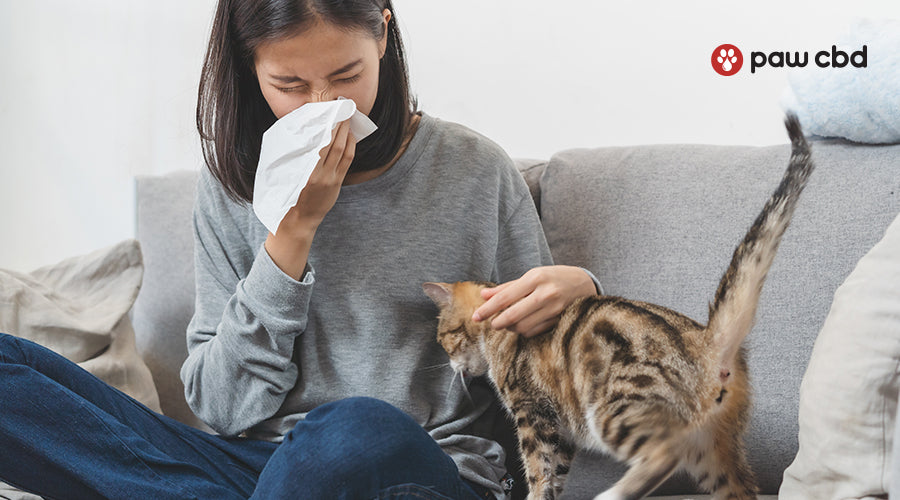Even those of us with pet dander allergies love animals and choose to live with them. Having a pet is such a precious experience that a little sneezing and sniffling is a small price to pay for many pet owners.
Pet dander allergies are a hassle, though, and there are several steps you can take to limit your allergic reaction and make daily life with your animal a little more comfortable. Here’s what you need to know about pet dander allergies and our tips for staying sneeze-free without sacrificing snuggles.
Understanding Pet Dander Allergies
Think you’re allergic to your pet? Here are answers to some common questions:
- What is dander?
- What are the common symptoms of a pet allergy?
- Can you be tested for pet dander allergies?
Most People With Pet Allergies Are Allergic to Dander
Dander is a term for extremely small, often microscopic, bits of skin that are shed by animals with fur or feathers, including dogs, cats, mice, and birds. Humans also have dander, and it’s often called dandruff and usually shed from the head.
Pet dander allergies are a specific type of pet allergy – people can also be allergic to other proteins in an animal’s saliva or skin. These allergies are prevalent because dander can be pervasive and not only gets into the animal’s fur but also spreads to various surfaces around the house. Controlling the spread of dander, especially in a home with many soft surfaces like beds and couches, and carpets, can be a challenge.

Common Symptoms of a Pet Dander Allergy
There are a variety of symptoms that might show up if you are allergic to pet dander. These can range from very minor symptoms, such as a runny nose, congestion, or sneezing, to more severe reactions like difficulty breathing or swelling of the throat and nose. Other symptoms that can be caused by a pet dander allergy include pain in the face from sinus pressure, coughing or wheezing, irritation in the eyes (itchiness, redness, or excessive watering), or skin reactions like hives and rashes.
These symptoms are common for many types of allergies, so none of these are unique indicators that a person is allergic to pet dander specifically. It’s possible your pet is bringing in an allergen from the outdoors, such as grass or pollen, and their dander alone doesn’t actually cause a reaction.
Testing and Diagnosis of Pet Dander Allergies
If you notice that your allergies lessen when you are away from your pet and away from home (where their pet dander is concentrated), then it’s likely the cause of your symptoms. But even if you’re confident that this is the cause of your allergies, you should still visit a doctor and get tested. In addition to considering your symptoms and medical history and giving you a physical examination, your doctor will likely do a skin or blood test that can help identify your specific allergy. Your doctor might also refer you to a specialty allergist for this testing and further care.
With a simple skin prick test, you can find out within 20 minutes or less if your pet is the reason for your symptoms. A small amount of the allergen is placed on the skin and then the skin is pricked so the allergen seeps into the skin. Your doctor then monitors that area for a reaction.
6 Tips for Reducing Your Pet Dander Allergies
If your pet dander allergy is not too severe, there are many ways you can manage your home and lifestyle to avoid symptoms. Some strategies include:
- Creating pet-free zones in the house
- Reducing carpets and soft surfaces
- Making it easy to wash fabrics in your home
- Bathing your pet regularly
- Grooming and brushing your pet outside the house regularly (or having a family member do so)
- Wearing a mask while vacuuming
Establish a Pet-Free Zone to Provide Relief
Establishing a pet-free zone in your home is advisable if you have pet dander allergies. This ensures that there is at least one section of your home where you can go for relief from your allergy symptoms, even if it’s only temporary.
Because we spend so much time in our bedrooms and comfortable, rejuvenating sleep is important to overall health (for both us and our pets), many people choose to make their bedroom a pet-free zone. Unfortunately, establishing a pet-free zone for allergy sufferers is more complex than just prohibiting the pet from spending time in that space. Pet dander can travel easily from room to room on the air or even on people’s shoes and clothing. It can also travel through air vents, so place cheesecloth over the vents in the pet-free zone.
To establish this zone, ensure that shoes are removed and clothes and body are clean before entering the pet-free zone. You might even try to change clothes before entering the pet-free zone, especially if you’ve been in close contact with the pet whose dander causes an allergic reaction. Keep the bedroom immaculately clean – change the sheets and bedding weekly and wipe down the walls. Dander is sticky and can collect on any surface.
Reduce Carpets and Soft Surfaces in the Home
If you suffer from pet dander allergies, it’s best to keep surfaces as bare as possible in your home. While pet dander can even stick to hard surfaces like wood and painted walls, those hard surfaces are easier to clean. If you can forgo rugs or switch out carpeting for hardwood or laminate flooring, it will make it easier to keep your home clean and dander-free. Likewise, try to switch out upholstered kitchen chairs for a wooden bench or ditch the throw pillows on your couch. Go with venetian blinds or other hard window treatments rather than drapes or curtains. When it comes to pet allergies, the less fabric and soft surfaces, the better.
Make It Easy to Wash Soft Surfaces and Fabrics in the Home
Eliminating every soft surface in your home would make it a very uninviting place for you and your family, and your pet probably wouldn’t like it, either! When you do need a soft, plush piece of furniture or home accessory, try to make it as easy as possible to wash and clean. Choose washable throw rugs over wall-to-wall carpet. Keep couches and upholstery covered with slipcovers that you can change out and toss in the washing machine. Don’t forget to wash curtains regularly, too.
The easier it is to clean these surfaces in your home, the more likely you’ll be to do it, which will hopefully reduce the amount of pet dander in your home and thus your allergic reaction.
Bath Your Pet Thoroughly and Regularly
A solid bathtime routine with your dog or cat can reduce the dander in your pet’s fur and keep their skin healthy so they don’t shed as many dry skin cells. You don’t want to wash your pet too often, which could actually dry out their skin and make their dander worse. But keeping to a consistent bath schedule such as once or twice a month will help with allergens.

You also want to use a pet shampoo like our Itchy Pup CBD Dog Shampoo that will keep your dog clean, moisturized, and relaxed during bath time. There are also dander control shampoos that you might consider – ask your veterinarian if this is an approach you want to take.
Groom Your Pet Outdoors and Enlist Help If Needed
Regular grooming such as brushing and even haircuts can reduce pet dander. Grooming should always be done outside or at a professional grooming facility. This way, the dander and fur that are removed during brushing end up outside rather than covering the home surfaces.
The person with the pet allergy shouldn’t be in charge of brushing or caring for the pet’s fur. (Furthermore, the person with the allergy shouldn’t clean the litter box or pick up pet waste from the yard – reducing their contact with the pet as much as possible will reduce their allergic reactions.)
Wear a Mask While Vacuuming, or Leave the House While Someone Else Does It
The good news about pet allergies? It might get you out of some chores, including vacuuming the house! Vacuuming stirs up dust and dander as it cleans, so those with pet allergies often find themselves sneezing or having more serious symptoms when they are vacuuming. It’s best for them to leave the house while this chore happens.
If you live alone, wear a dust mask while vacuuming to avoid inhaling too much dander. Vacuuming should happen regularly – even though it makes the allergies temporarily worse, it ultimately reduces the amount of dander in the home and makes it more comfortable for the allergy sufferer.
If Your Pet Allergies Are Serious, Consider a Hypoallergenic Pet
Pet dander allergies are specific to each person and each animal. Just because one dog makes you sneeze and cough doesn’t mean every dog will. Likewise, a dog allergy doesn’t mean you’ll have the same reaction to cats. If you’re an animal lover with significant allergies, you can also consider a hypoallergenic dog or cat breed. These animals still have dander, but tend to shed it less or the dander tends to be less triggering for allergy sufferers. You might also discuss medications for pet dander allergies with your doctor. If you're careful and intentional, even allergy sufferers can enjoy the pleasure of animal companionship.
PDS-GC-0250
